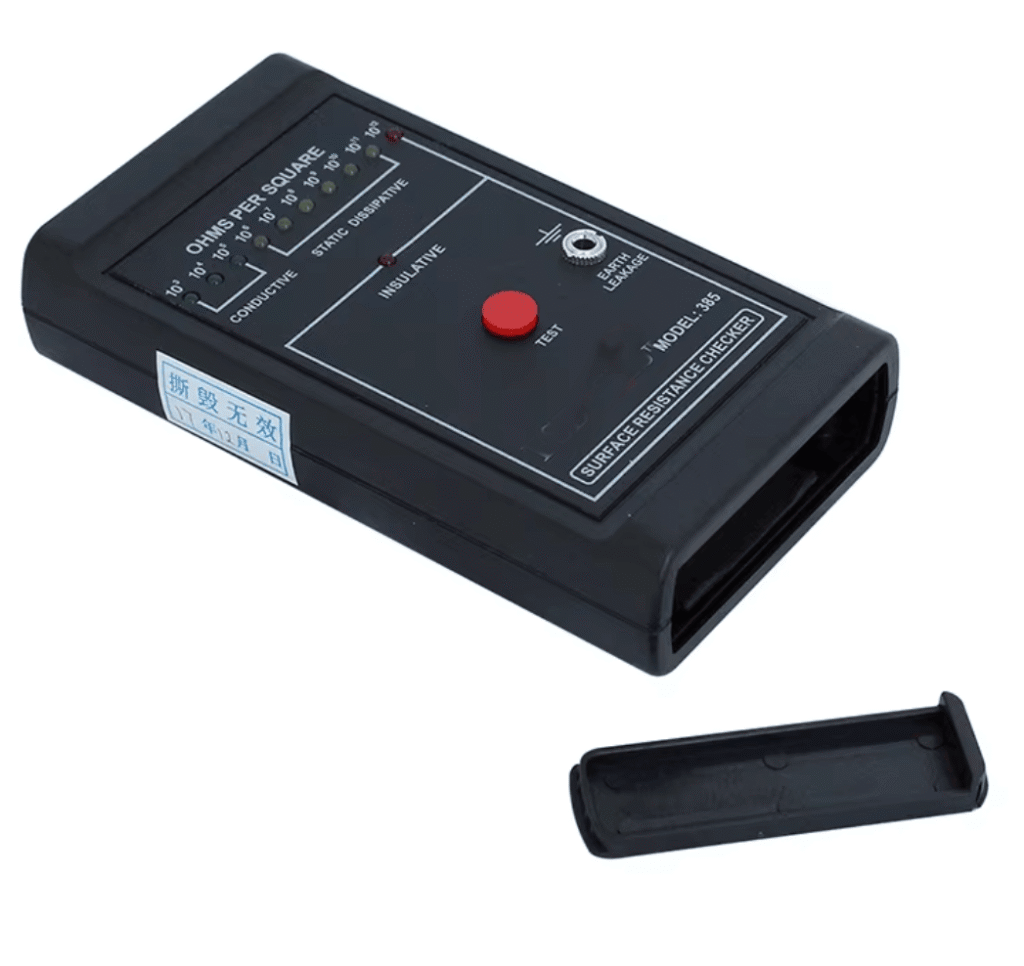Surface Resistance Meter

Product name | Surface Resistance Tester |
Material | ABS |
Power Supply | DC 9V battery |
Indication | Calibration impedance |
Application | Lab |
Accuracy | ±1/2 decades |
Resistivity Range | 10^2-10^12 Ohms |
Storage temperature | -15℃–60 ℃ |
Repeatability | +/-5% |
Function | Test |
Type | Portable Static Tester |
HORBEST HB1500A Surface Resistance Meter – Precise & Portable ESD Testing Tool
Working Principle:
The HORBEST HB1500A Surface Resistance Meter complies with ASTM D-257 testing standards. To measure, simply place the device on the target surface and press the red button. One of the ten LED indicators will light up, showing a resistance value from 10³Ω to 10¹²Ω/Insulative.
During testing, two parallel electrodes located at the bottom of the meter quickly evaluate the surface’s conductivity, electrostatic dissipation, and insulation properties.
Key Features of Surface Resistance Meter:
•Accurate measurement across a wide resistance range (10³Ω–10¹²Ω)
•Easy one-button operation with LED indication
•Compact and lightweight – ideal for field use and quick audits
•Fast and reliable Surface Resistance Meter for all ESD control programs
•Designed for mats, floors, shelves, ESD clothing, and more
Technical Specifications of Surface Resistance Meter:
•Model: HORBEST JH1500A
•Working Voltage: 9V DC
•Dimensions: 137mm × 76mm × 30mm
•Battery Life: Up to 40 hours
•Accuracy: ±1/2 decade
Whether you’re testing the surface resistance of floors, workstations, or ESD garments, the HORBEST Surface Resistance Meter is your dependable solution for static control verification.
Surface Resistance Meter
Surface Resistance Testing Methods and Standards – HORBEST Guide
Surface resistance testing involves various techniques and regulatory standards to ensure accurate evaluation of anti-static materials. The HORBEST Surface Resistance Meter supports these core methodologies, making it a reliable tool for ESD-safe environments and quality control.
I. Core Testing Methods
1. Four-Point Probe Method
This method uses two pairs of independent probes—one for applying current and another for measuring voltage—to eliminate contact resistance. It is ideal for testing uniform materials such as thin films and coatings.
•Accuracy: Within ±5%
•Advantages: Non-contact measurement, does not damage the sample
•Application: Common in semiconductor and coating industries
•Operation Tips: Current and voltage electrodes are separated; test voltage is typically 100V or 500V.
2. Three-Electrode Method (Concentric Ring Electrode)
This method separates current and voltage electrodes to reduce contact resistance, suitable for insulating or uneven surfaces.
•Operation Procedure:
•Place sample on an insulating surface with resistance >10¹³Ω
•Align the concentric ring electrode at the center
•Take readings at six different points and average the results
3. DC Comparison Method
Calculates resistance via the ratio of measured voltage and current. Suitable for conductive materials, it follows the GB/T 3048.5 standard.
•Voltage Range: 10V–1000V
•Benefit: Supports automated data acquisition for improved efficiency
4. Point-to-Point Method
Utilizes parallel electrodes spaced 25mm apart. Easy to operate and ideal for fast surface checks.
•Tip: Ensure surface is clean and free of scratches. Take three measurements and average the results.
II. Key Standards and Regulations
Standard Application Scope Key Requirements
GB/T 1410 General surface resistance in China Requires four-probe method, 23±2℃ / 50±5% RH
GB 50515-2010 Conductive flooring in chemical sites Resistance between 10⁴–10⁶Ω
IEC 61340-5-1 International ESD protection 100V test voltage, humidity range 30%–70%
ANSI/ESD S20.20 US standard 25mm electrode spacing, ≥5N contact pressure
GB/T 3048.5 Cable materials 20±2℃ / 50±5% RH; charge duration 1–5 minutes
III. Key Influencing Factors & Control
1. Environmental Conditions
•Temperature & Humidity: Standard testing conditions are 23±2℃ and 50±5% RH. A 10% rise in humidity may reduce resistance by up to 10x.
•Sample Conditioning: Samples should acclimate for 24 hours prior to testing.
2. Equipment Requirements
•Measurement Range: The Surface Resistance Meter should support readings from 10³ to 10¹²Ω.
•Calibration: Devices should be traceable to NIST standard resistors.
•Electrode Pressure: Maintain stable pressure at approximately 2.5kg during measurement.
3. Reading Stability
•Wait at least 15 seconds (at 500V) or 60 seconds (at 1000V) after applying voltage before recording the reading, to avoid polarization artifacts.
Why Choose the HORBEST Surface Resistance Meter?
HORBEST offers high-precision Surface Resistance Meters designed for accurate, fast, and compliant ESD testing. Whether you’re auditing a cleanroom, checking ESD floors, or verifying material compliance, HORBEST provides robust and reliable measurement solutions trusted by professionals worldwide.
📞 Contact Us Today
For bulk orders, quotes, or product guidance, get in touch with our expert team:
Email: sales2@esdbest.com
Phone: +86 137 1427 2599